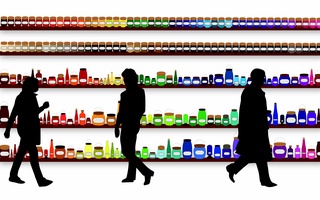On Thursday, the Harvard Art Museums stayed open late to welcome students back to campus and introduce their new director, Martha Tedeschi. With a night sky visible through Renzo Piano’s glass ceiling and a live band playing, hundreds of students milled in the museum’s central courtyard or filtered through the galleries. In a short speech at the beginning of the evening, Tedeschi spoke of her desire to make the museums an inviting space for students across the university. “There’s no right way or wrong way to use the art museums,” she said. She added that whether students wished simply to sit at at the courtyard cafe tables to study and socialize or to spend a few minutes with a work of art in the galleries, the museums belonged to them.
During the event, students wandered through the galleries in twos and threes, took tours with undergraduate student guides, looked through the offerings of the museums’ Student Print Rental Program, and sampled the Australian food themed to celebrate “Everywhen,” the special exhibition of Australian indigenous art currently on view at the museums. When asked, they gave a variety of reasons for coming to the Student Late Night. Alexandra S. Grimm ’17 climbed to the second floor with a few friends to find a favorite Degas sculpture. Now a senior in Leverett concentrating in English, she recalled her freshman year living in Greenough, when noise from the construction on the neighboring museums would wake her almost every morning. “It felt like a nice full circle to come back here at the beginning of my last year,” Grimm said. Maya Smith ’20 said that she had come mainly for the fun and the snacks. She added that she was undecided about her concentration but did not anticipate studying art or art history. David F. Clifton ’17, a classics concentrator, said that he often comes to the museums to find some quiet in the midst of campus.
According to Erin L. Northington, Manager of Student Engagement Programs at the museums, the Student Late Night continues the institution’s ongoing efforts to attract students from all disciplines and all schools of the University. “Broadly, one of my goals is always to make sure that students know that the museum is a place for them and that they have something to add to the conversations that happen here,” Northington said. “Our work is better and stronger and enriched by [their] questions and ideas and participation with our programs.” Northington, who was the main planner for the event, added that many of the ideas for Thursday’s activities, such as temporary tattoos featuring works from the collection, came from her conversations with students.
The late night at the Harvard Art Museums mirrors broader trends toward more participatory experiences and a greater focus on visitor engagement in art museums across the world in the past few years. Boston’s MFA, for instance, will offer a series of four all-night parties this fall as part of a seasonal program highlighting contemporary art. Northington emphasized, however, that the central focus of the museums remains the collections they house and the research they support. “With all of our programs, with whatever we’re doing, we’re always trying to connect back deeply to an idea, or to an exhibition that’s up, or to a research project from a current curator,” she said. “Even if it is a festive and fun evening, all of our ideas are really grounded in the collection and in the work of the museum.”
In an interview after her speech, Tedeschi emphasized her interest in the museum as an institution focused on teaching. “It’s exciting for me to be here, because what separates this job from my previous job is this intense focus on students and outreach to students,” said Tedeschi, whose appointment to the directorship was announced last March and who previously served as deputy director for art and research at the Art Institute of Chicago. “We have a sincere and abiding interest in the well-being and life of students, and we believe that the museums can be a part of that.”
She added that outreach to students has a variety of meanings, beginning with simply providing a break from day-to-day work. “There should be intriguing, small reasons that bring students to the museums. This is not about adding to their to-do lists,” she said. “There should be some surprise and delight about the experience.”
—Staff writer Elizabeth C. Keto can be reached at elizabeth.keto@thecrimson.com.Read more in Arts
‘Atlanta’ Polishes an Overdone PremiseRecommended Articles
-
Art Museum Director To Leave Harvard for LondonThe director of Harvard’s art museums announced earlier this month that he will be the latest in a series of
-
 New Curators Join the Renovated Harvard Art Museums
New Curators Join the Renovated Harvard Art Museums -
 One Year Later
One Year Later -
 Bringing the Collections to Life at the Art Study Center
Bringing the Collections to Life at the Art Study Center -
 Arts Asks: Jessica L. Martinez
Arts Asks: Jessica L. Martinez













